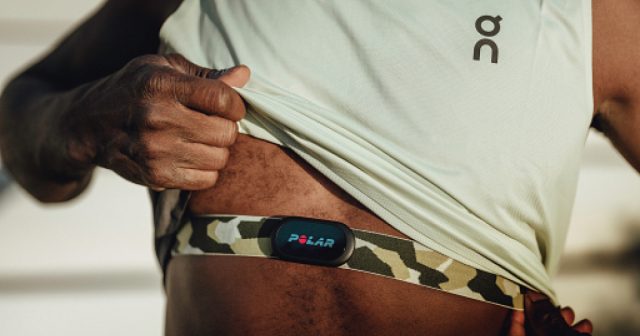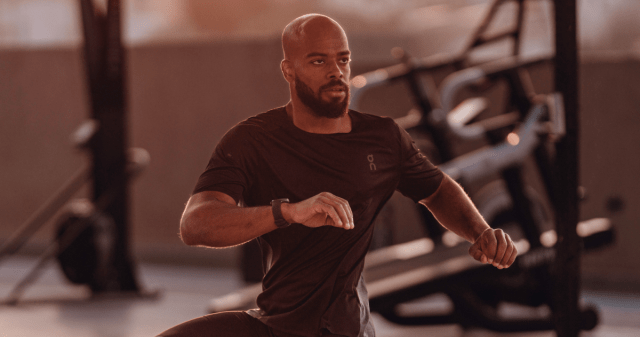Earlier in January, we concluded that the ideal approach is to combine HIIT and steady-state training to get the best results. Now, we’re continuing with the same topic with fitness expert Pete McCall, exploring how to choose the right exercise intensity.
When to HIIT and when not to HIIT? That is the question.
Which Is better: HIIT OR STEADY-STATE TRAINING?
Well, let’s back up a little and start with this question: Which is a more effective strategy for traveling from one place to another in the shortest period of time?
- Adding miles to your trip by driving the back streets of a city to avoid traffic jams
- Taking the shortest, most direct route even if it means sitting on a crowded freeway so congested that you only move a few miles an hour
To answer this question, consider the next question:
Which approach burns more gas and places more wear and tear on your car? The frequent starting and stopping of city driving or highway driving at a constant rate of speed?
The answers to the above questions provide a rough analogy of how the human body responds to different types of cardiorespiratory exercise.
Like HIIT, steady-state training can be effective for aerobic conditioning and burning calories but can require an extensive amount of time to do the volume of work necessary to achieve the desired results.
High-Intensity Interval Training (HIIT), which is similar to city driving, can be extremely effective for burning calories and improving aerobic capacity but at the expense of placing high levels of physical stress on the body.
On the other hand, steady-state training (SST) focuses on maintaining a consistent, low-to-moderate intensity work-rate for an extended period of time which is comparable to driving on a highway.
Like HIIT, steady-state training can be effective for aerobic conditioning and burning calories but can require an extensive amount of time to do the volume of work necessary to achieve the desired results.
This leads to the question: Is either HIIT or steady-state cardio a better form of training than the other?
Like in almost every answer to fitness-related questions, the first two words are: ‘That depends.’
your heart rate can help you choose the right exercise intensity
In the above car analogy, both options can help you get to your destination, but which one you choose depends on your personal preferences of whether you like sitting in slow-moving traffic or being in constant motion.
HIIT, while effective in terms of exercise intensity, could have a number of negative consequences, such as developing overtraining syndrome or causing a repetitive stress injury.
The goal should be to exercise smarter, not necessarily harder.
This doesn’t mean that you should avoid HIIT, rather, that you should limit yourself to three or fewer high-intensity workouts per week. To find the optimal amount for you, you need to know your heart rate to monitor your exercise intensity and organize your workouts. The goal should be to exercise smarter, not necessarily harder.
While seemingly counterintuitive, knowing how to properly perform your recovery cycles during an interval workout or plan your rest days between workouts can make an important and significant difference in your overall training plan.
The reality is that our fitness improves after the workout, not during it.
Plus, if you’re over the age of 35 it can take longer for your body to recover from a high-intensity workout, so knowing how to monitor exercise intensity in each workout and your overall training load can ensure you’re properly recovering after your hard training sessions.
The reality is that our fitness improves after the workout, not during it. If we’re constantly hammering as hard as we can with every workout, then we’re not allowing our bodies the necessary time to experience optimal recovery.
How to measure exercise intensity
There is a plethora of research validating each mode as an effective form of exercise so only you can determine which one is best suited to help you reach your fitness goals in the shortest period of time.
To help you choose the right workout intensity, here are the pros and cons for both HIIT and steady-state training with the heart rate zones you should be working in.
Steady-state training
Objective:
Maintain a consistent speed, level of intensity and work rate during an exercise session.
Pros:
- Exercising below the ventilatory threshold for an extended period of time places less physical stress on the cardiorespiratory system and can be an effective method for high-volume training to prepare for an endurance event.
- An established and proven method for improving cardiorespiratory fitness and enhancing aerobic capacity.
- Increase mitochondrial density in type I (slow-twitch) muscle fibers which can improve aerobic metabolism.
- Increase cardiac efficiency; specifically elevating stroke volume and cardiac output at a lower heart rate.
- Enhance ability to use fat as an efficient fuel source which reserves muscle glycogen to be used for higher intensity exercise.
- Steady-state training to improve aerobic efficiency generates less metabolic waste and cellular damage than HIIT workouts.
Cons:
- If the goal is weight loss, steady-state training may require extended periods of training time to achieve the desired level of caloric expenditure.
- Using steady-state training to improve aerobic capacity may require lengthy exercise sessions which can be a challenge for a busy lifestyle.
- Extended periods of exercise can increase the risk of repetitive stress injuries.
- Certain individuals may find it difficult to maintain the focus necessary to train at a constant work-rate for an extended period of time.
Measuring intensity:
- If the goal is weight loss, steady-state training may require extended periods of training time to achieve the desired level of caloric expenditure.
- Using steady-state training to improve aerobic capacity may require lengthy exercise sessions which can be a challenge for a busy lifestyle.
- Extended periods of exercise can increase the risk of repetitive stress injuries.
- Certain individuals may find it difficult to maintain the focus necessary to train at a constant work-rate for an extended period of time.
HIIT
Objective:
Alternate between periods of high intensity exercise and lower intensity recovery, either active or passive.
Pros:
- HIIT can be effective for improving aerobic capacity and/or calorie burning in a shorter period of training time when compared to high volume, steady-state training.
- The higher intensity work intervals of HIIT can be based on an individual’s RPE allowing that individual to start exercising at a relatively low intensity (as measured objectively) and progress from that initial starting point.
- Interval training may be an effective strategy for individuals who become easily distracted or ‘bored’ during longer exercise sessions.
- Can improve the efficiency of type II muscle fibers to produce energy via anaerobic glycolysis resulting in greater metabolic efficiency.
- Exercising above the lactate threshold can help stimulate the production of muscle-building, fat-burning hormones such as testosterone, growth hormone, and insulin-like growth factor.
- Increase the effect of EPOC (excess post-exercise oxygen consumption) helping to burn calories after the exercise session is completed.
Cons:
- High-intensity exercise increases mechanical damage on muscle tissue which could create soreness and perception of exercise as ‘painful’ in de-conditioned individuals.
- Anaerobic metabolism results in an accumulation of metabolic stress limiting a muscle’s ability to function.
- The high mechanical stresses of HIIT can increase the risk of injury from a muscle strain.
The higher exercise intensities required to improve aerobic conditioning with HIIT may be uncomfortable or painful for certain individuals. - An extended period of HIIT could deplete glycogen stores resulting in gluconeogenesis – the metabolic process of converting protein to produce glycogen; this limits the amount of protein available to repair muscle tissue damaged by exercise.
Measuring intensity:
- Both the higher intensity work intervals and lower intensity recovery periods can be measured as a percentage of MHR, HRR, VO2 Max, or an individual’s RPE.
- Keep your heart rate in Zones 4 and 5 for high-intensity work intervals during HIIT, allowing it to recover to Zones 1, 2, or 3 during the active rest intervals.
When is it time to turn up the HIIT?
In these five situations, HIIT might be the most effective workout for your needs.
1. You’re Busy.
You have a busy schedule that limits the time you can spend working out. HIIT workouts only take 30 minutes or less, which makes them extremely effective for producing results in a limited amount of time.
2. YOU FEEL STUCK.
You have been following the same cardio workout routine for a long time and have become stuck at a plateau, adding HIIT workouts could jumpstart your program so you continue experiencing results.
3. YOU WANT TO TRAIN FOR A MUD RUN OR OBSTACLE COURSE RACE.
These events feature physical challenges requiring anaerobic strength; HIIT can help you prepare to meet the demands of overcoming an obstacle while improving aerobic efficiency so you have the energy to finish the race.
4. YOU ARE EXERCISING FOR WEIGHT LOSS.
HIIT can help you burn more calories in a shorter period of time along with providing an EPOC effect to help you continue expending energy even after the workout is over.
5. BECAUSE YOU LIKE IT.
The best exercise in the world is… the one you enjoy and will do on a regular basis. If HIIT works for you, go for it and have fun but make sure you allow time for appropriate recovery because that’s where the real results happen.
When to keep your exercise intensity steady
These five reasons are valid for choosing steady-state training.
1. YOU’RE STRESSED.
You experience a period of high stress or find yourself wallowing in a grumpy mood, steady-state workouts place lower levels of physiological stress could help you to clear your mind and change your mood.
2. YOU PLAN TO ENTER A Long-Distance RACE.
According to the principle of specificity, the best way to train for an activity is to do the activity. If you want to complete an endurance race like a half marathon or marathon, you’ll need to make time for long-distance, steady-state training.
3. You want to explore.
When you’re visiting a new city or you’ve recently moved to a new area, a long steady-state run, bike ride or walk can be a great way to get out and explore an area.
4. YOU’RE EXERCISING FOR THE HEALTH BENEFITS.
Regular, low-to-moderate intensity steady-state exercise can provide a number of health benefits helping to reduce the risk of developing a chronic disease like onset diabetes, high blood pressure, or high cholesterol.
5. BECAUSE YOU LIKE IT.
Some people simply enjoy going out for long runs or training for long-distance endurance events, if this is you there is no reason to change your workout habits as long as they provide you with the benefits you are looking for, enjoy!
Varying exercise intensity is key
There are a number of different ways to organize workouts to alternate between HIIT and aerobic steady-state or sub-maximal interval training.
Having the ability to measure your heart rate and identify which zone you’re in is important for achieving specific training goals.
Training in all five heart rate training zones will help you burn calories, but having the ability to measure your heart rate and identify which zone you’re in is important for achieving specific training goals.
When it comes to getting long-term benefits from exercise, it is definitely better to train smarter as opposed to pushing yourself to work harder.
You can still do your HIIT workouts, but it’s a good idea to limit them to three times per week or less and only on those days when you know you can get a full night’s sleep which is a key component of the post-exercise recovery and repair process.
If you’re not already doing some form of sub-maximal, steady-state aerobic conditioning then you should consider adding it to your program. Even though it may not feel that challenging, think of it like driving on the highway: an efficient use of energy with less stress on the body.
If you liked this post, don’t forget to share so that others can find it, too.
Or give it a thumbs up!
I like this article
Please note that the information provided in the Polar Blog articles cannot replace individual advice from health professionals. Please consult your physician before starting a new fitness program.





